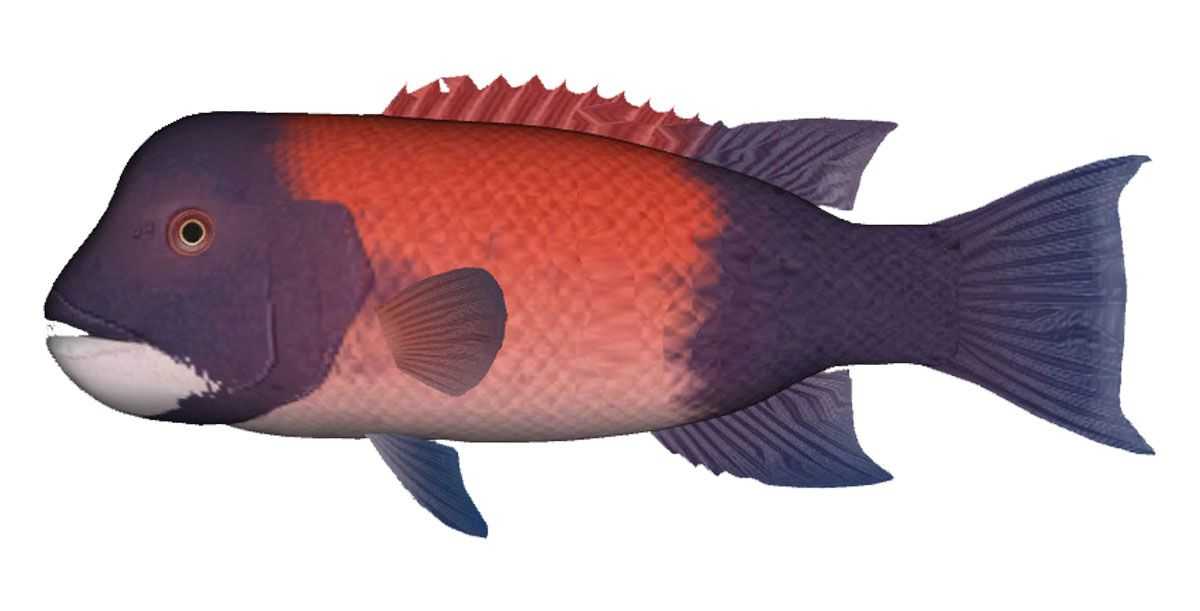California Sheephead

Species Details
Semicossyphus Pulcher
Labridae
Perciformes
Onshore, Nearshore, Offshore, Reef, Wreck
2 - 20 lbs.
6" - 36"
California Sheephead (Semicossyphus pulcher) Fish Description
The California Sheephead (Semicossyphus pulcher) is a saltwater fish and one of the largest members of the wrasse family. It can easily be distinguished by its rather unique color patterns. The males, aside from being much bigger than females, are more colorful with their dark black heads and hind parts, orange to reddish middle sections, red eyes, and white chin and bellies. The females, on the other hand, also have white chins and bellies but don’t have the black heads and tails as males do. Their color is also rather duller compared to males with their orange to pinkish colors. Another feature to tell males apart from females is the fleshy bumps on their foreheads.
The California Sheephead is a carnivorous fish that dwells in reefs and other rocky habitats as well as kelp forests underneath the ocean. It actively hunts during the day and prey on hard-shelled creatures living in the same habitat. It uses its powerful jaws and large protruding teeth to crush the shells of lobsters, crabs, urchins, and molluscs; although, it occasionally eats other smaller fishes and squids. At night, it usually hides inside underwater caves and crevasses as well as covers itself with a protective mucus “cocoon” that hides its scent from predators while it sleeps.
Between June and September, the spawning season occurs. During this time, the males become more aggressive and territorial as they defend their turf against intruders—including other male Sheepheads. While the male protects their territory, the females would release their eggs—a female can produce between 130,000 and 375,000 eggs in a day—in a water column. The males would then release their sperms to fertilize the eggs. As soon as the eggs get fertilized, they would be carried away by the current and get scattered along the coastal areas until they hatch into larvae. And because they are left to fend for themselves, most of the young Sheepheads wouldn’t survive. Those that survive and are lucky enough to reach adulthood, however, have been known to live for a long time in the wild at an average of twenty to thirty years—with some even reaching up to more than fifty years, according to some reports.
Interesting Facts
- There were reports of California Sheephead reaching three feet in length and over thirty-five pounds in weight in the wild.
- The biggest ever caught on record was a 35-pounder by Venturan angler Brad Johnston just three miles off La Jenelle Beach in Oxnard California.
- They are protogynous—meaning, all of them are born females.
- The bigger more dominant ones will change to male when they reach a certain age.
- They live within a harem where a single often dominant male travels around with a number of females.
- As predators, they play a critical role in the growth and biodiversity of reefs and kelp forests.
- They are often caught by anglers for their mildly sweet white meat, with some even saying their meat kind of tastes like lobster meat.
- They can also be kept in aquariums.
- The fish species were placed under the IUCN's Red List of Threatened Species due to overfishing.
- Regulations and restrictions were placed by the authorities to help save the species.
- Restrictions include catch limits for recreational fishers and seasonal fishing allowances for commercial fishers.
Average Size
As one of the biggest members of the wrasse family, the California Sheephead has been known to reach a maximum size of three feet, weighing over thirty-five pounds. Average sizes that were caught, however, can range from two to twenty pounds, depending on the sex and the location where you caught the fish.
Habitat and Distribution
As per its name, the fish can be found pretty much near the coastlines of California—from Monterey Bay to San Diego. It can, however, also be found on both sides of the Baja Peninsula in Mexico. The fish is said to be most abundant from Point Conception to the Baja California as well as on the other side of the peninsula in the Gulf of California. And if you’re targeting bigger ones, you might want to check out around the waters of some islands off the coast of California, particularly in Channel, Santa Rosa, San Nicolas, and San Clemente islands.
California Sheepheads prefer to live at the bottom of the sea, often in reefs and other rocky areas that are nicely vegetated, especially within kelp forests. They can also be found usually at depths ranging from ten to fifteen feet.
California Sheephead Fishing Tips
Although Sheepheads are fairly easy to locate and can, again, be fairly easy to hook just by presenting your bait near the bottom with clams, crabs, mussels, sea urchins, and other hard-shelled creatures, they can really be difficult to land. This is because they are known to put up a tough resistance when hooked given their capability to swim fast and strong and their ability to swim away quickly in powerful bursts. They are also known to use their rocky surroundings, swimming around underwater structures to try and snap off your line. So if you happen to hook a California Sheephead, especially if it’s a large one, get ready for a long and tiring battle. And if it’s able to reach the rocky bottom, you can definitely say goodbye to this prized fish.
For the gear, we suggest a heavy tackle with a 40lb leader paired with a braided line for you to be able to handle this spunky fish. You can also employ some chumming if you’re having a hard time getting them to take your bait.







